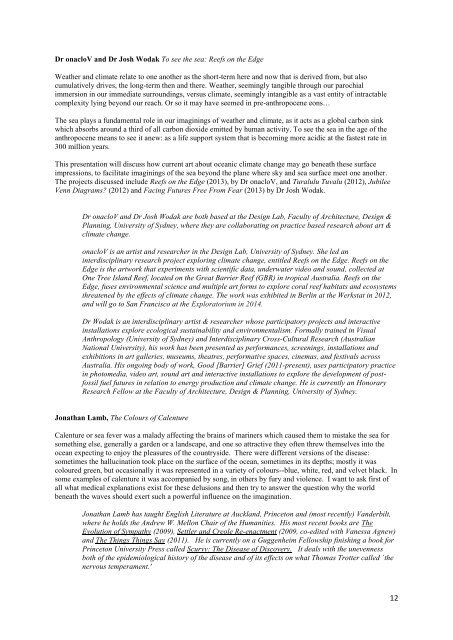Symposium Agenda - The University of Sydney
Symposium Agenda - The University of Sydney
Symposium Agenda - The University of Sydney
Create successful ePaper yourself
Turn your PDF publications into a flip-book with our unique Google optimized e-Paper software.
Dr onacloV and Dr Josh Wodak To see the sea: Reefs on the Edge<br />
Weather and climate relate to one another as the short-term here and now that is derived from, but also<br />
cumulatively drives, the long-term then and there. Weather, seemingly tangible through our parochial<br />
immersion in our immediate surroundings, versus climate, seemingly intangible as a vast entity <strong>of</strong> intractable<br />
complexity lying beyond our reach. Or so it may have seemed in pre-anthropocene eons…<br />
<strong>The</strong> sea plays a fundamental role in our imaginings <strong>of</strong> weather and climate, as it acts as a global carbon sink<br />
which absorbs around a third <strong>of</strong> all carbon dioxide emitted by human activity. To see the sea in the age <strong>of</strong> the<br />
anthropocene means to see it anew: as a life support system that is becoming more acidic at the fastest rate in<br />
300 million years.<br />
This presentation will discuss how current art about oceanic climate change may go beneath these surface<br />
impressions, to facilitate imaginings <strong>of</strong> the sea beyond the plane where sky and sea surface meet one another.<br />
<strong>The</strong> projects discussed include Reefs on the Edge (2013), by Dr onacloV, and Turalulu Tuvalu (2012), Jubilee<br />
Venn Diagrams? (2012) and Facing Futures Free From Fear (2013) by Dr Josh Wodak.<br />
Dr onacloV and Dr Josh Wodak are both based at the Design Lab, Faculty <strong>of</strong> Architecture, Design &<br />
Planning, <strong>University</strong> <strong>of</strong> <strong>Sydney</strong>, where they are collaborating on practice based research about art &<br />
climate change.<br />
onacloV is an artist and researcher in the Design Lab, <strong>University</strong> <strong>of</strong> <strong>Sydney</strong>. She led an<br />
interdisciplinary research project exploring climate change, entitled Reefs on the Edge. Reefs on the<br />
Edge is the artwork that experiments with scientific data, underwater video and sound, collected at<br />
One Tree Island Reef, located on the Great Barrier Reef (GBR) in tropical Australia. Reefs on the<br />
Edge, fuses environmental science and multiple art forms to explore coral reef habitats and ecosystems<br />
threatened by the effects <strong>of</strong> climate change. <strong>The</strong> work was exhibited in Berlin at the Werkstat in 2012,<br />
and will go to San Francisco at the Exploratorium in 2014.<br />
Dr Wodak is an interdisciplinary artist & researcher whose participatory projects and interactive<br />
installations explore ecological sustainability and environmentalism. Formally trained in Visual<br />
Anthropology (<strong>University</strong> <strong>of</strong> <strong>Sydney</strong>) and Interdisciplinary Cross-Cultural Research (Australian<br />
National <strong>University</strong>), his work has been presented as performances, screenings, installations and<br />
exhibitions in art galleries, museums, theatres, performative spaces, cinemas, and festivals across<br />
Australia. His ongoing body <strong>of</strong> work, Good [Barrier] Grief (2011-present), uses participatory practice<br />
in photomedia, video art, sound art and interactive installations to explore the development <strong>of</strong> postfossil<br />
fuel futures in relation to energy production and climate change. He is currently an Honorary<br />
Research Fellow at the Faculty <strong>of</strong> Architecture, Design & Planning, <strong>University</strong> <strong>of</strong> <strong>Sydney</strong>.<br />
Jonathan Lamb, <strong>The</strong> Colours <strong>of</strong> Calenture<br />
Calenture or sea fever was a malady affecting the brains <strong>of</strong> mariners which caused them to mistake the sea for<br />
something else, generally a garden or a landscape, and one so attractive they <strong>of</strong>ten threw themselves into the<br />
ocean expecting to enjoy the pleasures <strong>of</strong> the countryside. <strong>The</strong>re were different versions <strong>of</strong> the disease:<br />
sometimes the hallucination took place on the surface <strong>of</strong> the ocean, sometimes in its depths; mostly it was<br />
coloured green, but occasionally it was represented in a variety <strong>of</strong> colours--blue, white, red, and velvet black. In<br />
some examples <strong>of</strong> calenture it was accompanied by song, in others by fury and violence. I want to ask first <strong>of</strong><br />
all what medical explanations exist for these delusions and then try to answer the question why the world<br />
beneath the waves should exert such a powerful influence on the imagination.<br />
Jonathan Lamb has taught English Literature at Auckland, Princeton and (most recently) Vanderbilt,<br />
where he holds the Andrew W. Mellon Chair <strong>of</strong> the Humanities. His most recent books are <strong>The</strong><br />
Evolution <strong>of</strong> Sympathy (2009), Settler and Creole Re-enactment (2009, co-edited with Vanessa Agnew)<br />
and <strong>The</strong> Things Things Say (2011). He is currently on a Guggenheim Fellowship finishing a book for<br />
Princeton <strong>University</strong> Press called Scurvy: <strong>The</strong> Disease <strong>of</strong> Discovery. It deals with the unevenness<br />
both <strong>of</strong> the epidemiological history <strong>of</strong> the disease and <strong>of</strong> its effects on what Thomas Trotter called `the<br />
nervous temperament.'<br />
12
















